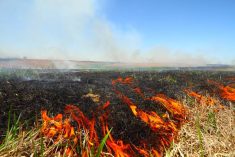Farm equipment is getting bigger and it’s no longer uncommon to see air seeders in the 75-foot-wide range that fold up to considerable height in transport mode as well.
But when is big too big?
Or more precisely, when is ag equipment too large to safely clear power lines?
Last year, Fortis Alberta responded to 20 incidents of sprayers and air seeders coming into contact with power lines — triple the number from four years earlier.
And in the past two years, there were three incidents in which ag equipment came into contact with power lines that sent people to hospital with serious injuries, said the company, which provides electricity to 60 per cent of Alberta’s rural areas.
Read Also

Grazing ‘sweet spot’ boosts pasture performance
Timing-focused approach to pasture management touted to boost forage growth, livestock gains while also cutting farmer labour and inputs
“Two years ago two individuals had to be taken by STARS air ambulance to medical facilities in cities (after an electrical contact). That really concerns us greatly,” said Fortis spokesperson Mona Bartsoff.
She emphasized that Fortis is not pointing any fingers at farmers, but the simple fact is that agriculture equipment has grown — both up and out.
“I’m from a farm background myself,” said Bartsoff. “We realize that farmers have a great responsibility. In a short period of time they have to be everything: owner, operator, mechanic, welder, agronomist and then on top of it all, you’re the safety manager. You need to be aware of not only what’s going on, on the ground but you have to watch the power lines as well.”
There are resources that can help, she said, noting linemen from her company can assist producers in planning transport routes so they don’t run into any surprises.
“Honestly, reach out to us because we want to be able to help you get home to your families safely,” said Jamie Irving, who also works in Fortis Alberta’s communications department.
A (literally) growing problem
According to Fortis, the maximum height field-bound agriculture equipment can be to ensure safe clearance under an overhead power line is 4.2 metres (13.7 feet). That’s the maximum for entrances to farmyard or field access roads. For roads and highways, the maximum is 5.3 metres (17.3 feet).
The company also recommends staying seven metres (23 feet) away from a power line.
“When I say size I’m not only referring to the height — I’m referring to the width,” said Bartsoff. “Very often (a seeder or sprayer) in working mode with the wings out have snagged a guy wire.”
There have been more incidents in southern Alberta and although it’s not clear why, the size of an operation and its equipment seem to be a factor.
“We had twice as many incidents in the area around Lethbridge, Coaldale and Taber than we did in the other parts of the province in our service territory,” she said. “In dryland farming, the size of this equipment is huge simply because it takes bigger pieces of equipment to farm as many acres required these days to be viable.”
If the height of your load is more than 4.15 metres (13.6 feet), it’s considered “over height” and you will require a permit from Alberta Transportation.
The electrical utility in your area may be able to help you prepare a route that will avoid power lines.
“Call our main number, which is 310-WIRE, and then the call gets dispatched to the appropriate service point,” said Bartsoff. “They will then dispatch a power lineman to have that conversation with the farmer.”
Atco — the other big rural electricity utility — provides help with high load moves depending on the situation. Call 1-855-277-1670 for more information.
Overhead power lines are not the only hazard with large equipment. According to Fortis, there were six incidents of excavators and backhoes connecting with underground power lines on agricultural operations in 2021. To find out the location of a buried power line, go to utilitysafety.ca (click on the Click Before You Dig icon) or call 1-800-242-3447.
A farmer who comes into contact with a power line and is at fault is on the hook for damages. Bartsoff doesn’t have any numbers on how much the bills for damages are, but said they’re generally into the thousands.
Hit a line? Stay calm
If you make contact with a power line, the first (although arguably the most difficult) step is to stay calm, said Bartsoff. Ideally you’ll want to try to break the contact and then drive at least 10 metres away from the site of contact. If you can’t break the contact, stay in the cab of the vehicle unless there’s the threat of a fire.
“Call 911 and call us at our 24-hour emergency line (310-WIRE) and we will be right out there to de-energize the line,” she said.
Make sure anyone on the ground stays at least 10 feet away from the contact site. Don’t assume that first responders will know exactly what’s going on — communicate with them in whatever way you can.
“When the first responders arrive you need to yell at them and tell them to stay back,” said Bartsoff. “They won’t necessarily see that a line is down so it’s extremely important that they be kept safe as well.”
If there’s a fire, you’re going to have to jump clear of the vehicle to avoid injury. Jump to the ground with your feet together tightly and slowly shuffle or hop for about 10 metres in that position.
You might be wondering why your feet have to stay together.
“An energized ground is like the base of a pond,” said Bartsoff. “There are concentric circles of different potentials and when you separate your feet you create two different potentials and then the electricity can travel through your body.”
















